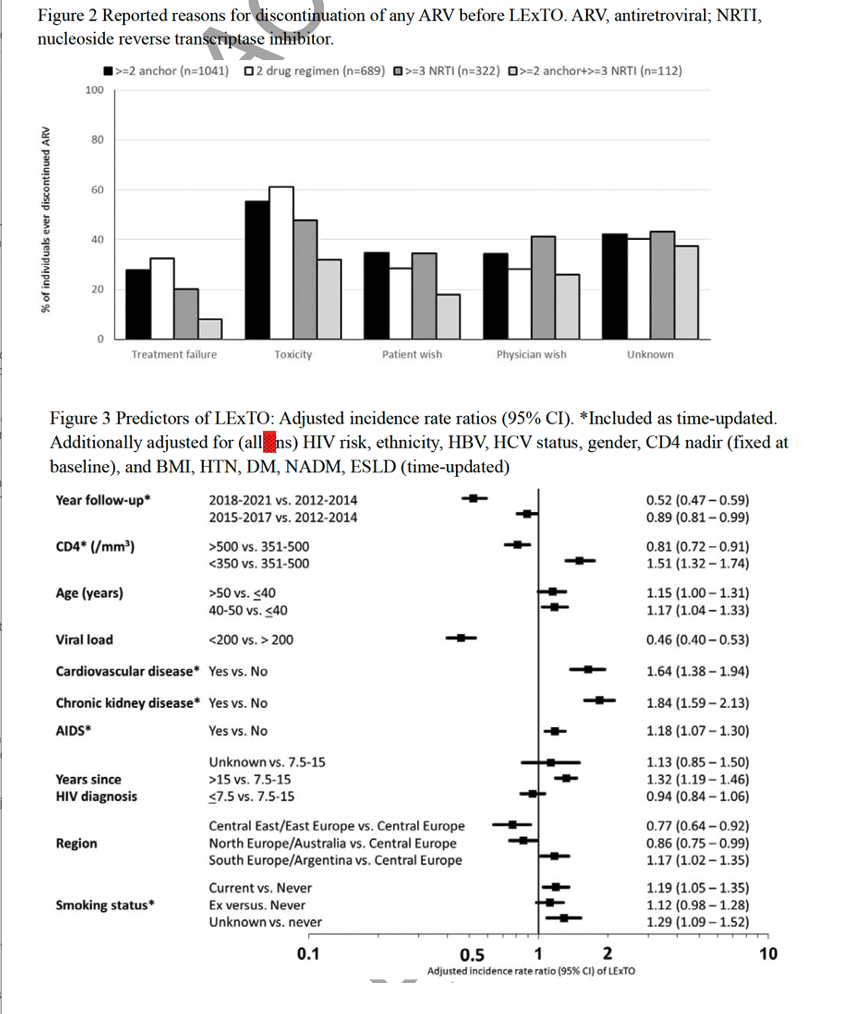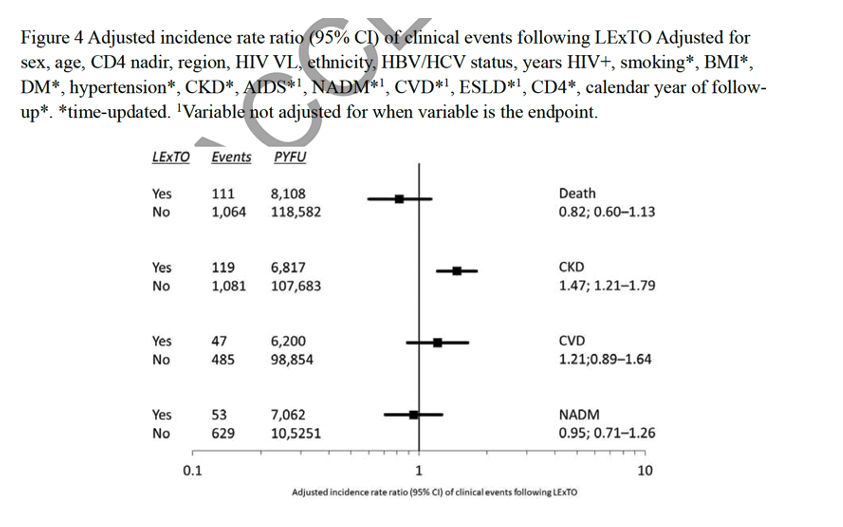| |
Heavy arv exposure and exhausted/limited arv options:
predictors and clinical outcomes
|
| |
| |
Download the PDF here
People with HIV and extensive antiretroviral exposure may have limited/exhausted treatment options (LExTO) due to resistance, comorbidities, or antiretroviral-related toxicity. Predictors of LExTO were investigated in the RESPOND cohort.
As expected, individuals with ongoing comorbidities, including CVD and CKD also had higher rates of LExTO.
Persons with detectable viremia and low CD4 cell counts had higher rates of LExTO, consistent with other studies using alternative definitions(4). Persons with detectable viremia and/or lower CD4 cell count reflect those who were failing previous regimens, with the greatest chance of drug resistance(24).
While previous research has suggested higher rates of clinical events following triple class failure and more extensive treatment (11, 24, 30), apart from CKD, we found similar rates of clinical outcomes in those with and without LExTO after adjustment for relevant confounders, most notably age and CD4 cell count. One possible rationale for the higher rates of CKD in those with LExTO could be extensive exposure to tenofovir disoproxil fumarate and several older ritonavir-boosted PIs, given the association with CKD (31). The number of effective ARVs has expanded in recent years, with ibalizumab, fostemsavir and lenacapavir available to those with limited treatment options; there were no individuals from RESPOND who had started these ARVs. Nonetheless, those with LExTO now have a wider range of options including more potent salvage regimens, ARVs from entirely new classes being introduced, regimens constructed based on knowledge of HIV resistance and use of ARVs with fewer severe adverse events and less potential for drug-drug interactions (32-35). These factors may all potentially reduce the incidence of serious clinical events following LExTO to the level seen in our analysis. Crude mortality rates from studies which have considered clinical outcomes are 1.5-2-fold higher in those with HTE (9-11), consistent with our unadjusted analysis of LExTO, although adjusted rates were not presented in these studies(9, 11).
To conclude, LExTO was associated with longer duration of HIV infection, older age, low CD4 cell count, ongoing viremia and comorbidities such as CVD and CKD, but not with gender. After adjustment for age and CD4, it was reassuring to note that LExTO was not associated with a significantly increased incidence of serious clinical events apart from CKD. Continued long-term follow-up with monitoring of the prevalence and outcomes of LExTO remains important to identify trends going forwards as the population with HIV continues to age and new ARVs are developed.
Abstract
Objectives:
People with HIV and extensive antiretroviral exposure may have limited/exhausted treatment options (LExTO) due to resistance, comorbidities, or antiretroviral-related toxicity. Predictors of LExTO were investigated in the RESPOND cohort.
Methods:
Participants on ART for at least 5 years were defined as having LExTO when switched to
- at least two anchor agents and one-third antiretroviral (any class),
- a two-drug regimen of two anchor agents (excluding rilpivirine with dolutegravir/cabotegravir),
- or at least three nucleoside reverse transcriptase inhibitors.
Baseline was the latest of January 1, 2012, cohort enrolment or 5 years after starting antiretrovirals. Poisson regression modeled LExTO rates and clinical events (all-cause mortality, non-AIDS malignancy, cardiovascular disease [CVD], and chronic kidney disease [CKD]).
Results:
Of 23 827 participants, 2164 progressed to LExTO (9.1%) during 130 061 person-years follow-up (PYFU); incidence 1.66/100 PYFU (95% CI 1.59-1.73).
Predictors of LExTO were HIV duration more than 15 years (vs. 7.5-15; adjusted incidence rate ratio [aIRR] 1.32; 95% CI 1.19-1.46), development of CKD (1.84; 1.59-2.13), CVD (1.64; 1.38-1.94), AIDS (1.18; 1.07-1.30), and current CD4+ cell count of 350 cells/μl or less (vs. 351-500 cells/μl, 1.51; 1.32-1.74).
In this study, individuals with LExTO had extensive ARV experience with exposure to a median of 7 ARVs prior to LExTO, and a median time since first starting ARVs of 13.5 years. The reasons for stopping any prior ARV before LExTO varied. Treatment failure was reported as a reason for prior discontinuation of any previous ARV in approximately one-quarter of individuals and was highest in those with a 2-drug LExTO regimen. ARV-related toxicities and patient/physician choice were common reasons for prior ARV discontinuation for all with h LExTO and particularly for those with a 2-drug LExTO regimen. This could suggest a move to a simpler regimen and/or wanting to reduce potential ongoing risks associated with use of some ARVs in an aging population(16, 17).
Those followed between 2018 and 2021 had lower rates of LExTO (vs. 2015-2017; 0.52; 0.47-0.59), as did those with baseline viral load of 200 cp/ml or less (0.46; 0.40-0.53) and individuals under 40. Development of LExTO was not significantly associated with clinical events after adjustment for age and current CD4, except CKD (1.74; 1.48-2.05).
Experience of AIDS, CKD, and CVD were all associated with a significantly increased incidence of LExTO, as were current and past smokers, while there was no association with NADM, ESLD, DM and hypertension. Of note, there was no difference between males and females in incidence of LExTO (aIRR 0.93; 95% CI 0.83-1.04
Conclusion:
Despite an aging and increasingly comorbid population, we found declining LExTO rates by 2018-2021, reflecting recent developments in contemporary ART options and clinical management. Reassuringly, LExTO was not associated with a significantly increased incidence of serious clinical events apart from CKD.


|
|
| |
| |
|
|
|